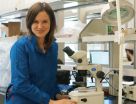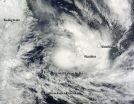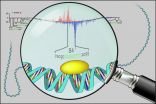(Press-News.org) The relationship between human disease and environmental management has been the subject of extensive research, especially given the recent outbreaks of Ebola, SARS and other zoonotic infectious diseases that transmit from animals to humans.
The fieldwork of UC Santa Barbara community ecologist Hillary Young is a good example of researchers' continuing effort to understand exactly how environmental management affects disease emergence. In East Africa, Young examines the direct impacts of human disturbance on landscape and wildlife, as well as a variety of factors affecting infectious disease risk.
Young posits that rodent-borne pathogens are likely to demonstrate the synergies between conservation and human health. In three recently published papers, she takes separate approaches to addressing the question of what human disturbance is doing to human health.
"I ask this overarching question in a variety of ways," said Young, an assistant professor in UCSB's Department of Ecology, Evolution and Marine Biology. "All three papers try to come at that question from different directions, and acknowledge that there is no single answer.
"We can disturb environments in myriad different ways, with diverse and cascading impacts across taxa -- thus affecting disease risk in diverse and indirect ways," she added. "In order to move to a more predictive understanding of the relationship between disturbance and disease, we need to understand the nuances and the mechanisms of what's going on, in order to understand which pathogens are likely to cause effects on human health and in what context."
One important human influence is land-use change. Young's first study, published in the American Journal of Tropical Medicine and Hygiene, found that as croplands expanded in northern Tanzania, so did plague-carrying rodents. This study demonstrates that agricultural conversion increases the risk of bubonic plague by moving flea-infested rodents closer to human habitats, making transmission of the plague pathogen, Yersinia pestis, that much easier.
"We found that introducing maize production in natural areas appears to create a perfect storm for plague transmission," Young said. "The presence of the crop as a food source caused a surge in the population of a rat species known to carry plague. Local farmers often then store this harvested corn next to or inside their homes -- baiting in the hungry field rats and increasing opportunities for human infection. These kinds of conditions can breed outbreaks."
Because fleas act as vectors for all kinds of zoonotic diseases, including bubonic plague, Young and her colleagues wanted to determine what elements affect the intensity of flea infestation on small rodents. Is it the species? Body size? Diversity? Environmental factors? Ultimately, they wanted to know whether science could predict the abundance of fleas, particularly of those few flea species that bite both humans and rodents. The findings of this study are published in the Journal of Parasitology.
To answer these questions, Young and her team conducted research in Kenya over a four-year period. They sampled more than 2,600 small mammals and many thousands of fleas from 27 species to examine the relationship between rodents and fleas across individuals in a population, across populations within a species and across species within a landscape. They discovered that for any given species, density drives the number of fleas on an animal.
Curiously, the research also showed that environmental conditions -- in this case, the amount of vegetation -- affected populations of a single species across a landscape. "Surprisingly to me, less vegetation cover means more fleas per rodent," Young noted.
Across host species in the landscape, the researchers found that rodent body size increased both the prevalence and the intensity of flea infestations. These results provide insight into the intricate roles of both host and environmental factors in explaining the patterns of flea infestations across different types of landscapes. "Then the few species of fleas that will bite humans become really critically important in predicting diseases," Young said.
Drawing on this same dataset for a third paper, Young shifted her focus to the rodents' hosts, specifically examining how wildlife loss and land-use change affected their abundance and composition. The study is published in the journal Ecological Applications.
Here, Young and her colleagues found that the loss of large wildlife creates systematic changes to the variety of species that are present. However, these changes are context-dependent, with rainfall playing a particularly important role. According to Young, comprehending this context dependence is critically important to both understanding and predicting the effects of future change and to prioritizing areas for large wildlife conservation.
"Given the many ways wildlife loss and land use change can affect rodent-borne disease, we need to better elucidate the mechanisms by which these changes occur if we hope to develop better predictive capacities to both conserve landscapes and protect human health," Young said.
INFORMATION:
Tropical Cyclone Haliba formed east of the island nation of Madagascar in the Southern Indian Ocean and is now affecting the La Reunion and Mauritius islands. NASA's Terra satellite passed over Haliba on March 9 and captured an image of the storm that showed the eastern quadrant was affecting the two smaller islands.
The Moderate Resolution Imaging Spectroradiometer (MODIS) instrument aboard NASA's Terra satellite captured a visible image of Tropical Cyclone Haliba on March 9 at 06:35 UTC (2:35 a.m. EDT). The image showed both La Reunion and Mauritius islands were covered ...
Although many people value receiving information about incidental findings identified from genomic sequencing, not everyone wants to know about genetic conditions regardless of potential health implications, found a study of Canadian preferences in CMAJ (Canadian Medical Association Journal).
An incidental finding refers to discovery of a genetic condition that may cause a disease, but the finding is unrelated to why genomic testing was initially ordered by the physician. For example, a test to determine if there is a genetic cause of a patient's colon cancer may find ...
In a screen of more than 100,000 potential drugs, only one, harmine, drove human insulin-producing beta cells to multiply, according to a study led by researchers at the Icahn School of Medicine at Mount Sinai, funded by JDRF and the National Institutes of Health, and published online today in Nature Medicine.
Diabetes results from too few insulin-producing "beta cells" in the pancreas secreting too little insulin, the hormone required to keep blood sugar levels in the normal range. The disease affects 380 million people worldwide, and leads to major medical complications: ...
COLLEGE PARK, Md. -- An analysis of changes to the climate that occur over several decades suggests that these changes are happening faster than historical levels and are starting to speed up. The Earth is now entering a period of changing climate that will likely be faster than what's occurred naturally over the last thousand years, according to a new paper in Nature Climate Change, committing people to live through and adapt to a warming world.
In this study, interdisciplinary scientist Steve Smith and colleagues at the Department of Energy's Pacific Northwest National ...
Activity in a brain area known as the dorsal posterior insula is directly related to the intensity of pain, a brain imaging study of 17 people has found.
Researchers at the Oxford Centre for Functional Magnetic Resonance Imaging of the Brain used a new brain imaging technique to look at people experiencing pain over many hours. Activity in only one brain area, the dorsal posterior insula, reflected the participants' ratings of how much the pain hurt.
These results, published in the journal Nature Neuroscience, could help detect pain in people with limited communication ...
Scientists have discovered another 15 genetic 'hot-spots' that can increase a woman's risk of developing breast cancer, according to research published today (Monday) in Nature Genetics.
In a study funded by Cancer Research UK*, scientists compared tiny variations in the genetic make-up of more than 120,000 women of European ancestry, with and without breast cancer, and identified 15 new variations - called single nucleotide polymorphisms (SNPs) - that are linked to a higher risk of the disease.
This new discovery means that a total of more than 90 SNPs associated with ...
Kansas City, MO. -- All the cells in an organism carry the same instruction manual, the DNA, but different cells read and express different portions of it in order fulfill specific functions in the body. For example, nerve cells express genes that help them send messages to other nerve cells, whereas immune cells express genes that help them make antibodies.
In large part, this highly regulated process of gene expression is what makes us fully functioning, complex beings, rather than a blob of like-minded cells.
Despite its importance, researchers still do not completely ...
PHILADELPHIA--Treating metastatic melanoma with a triple threat--including radiation therapy and two immunotherapies that target the CTLA4 and PD-1 pathways--could elicit an optimal response in more patients, one that will boost the immune system's attack on the disease, suggests a new study from a multidisciplinary team of researchers from Penn's Abramson Cancer Center published today in Nature.
The study, led by senior authors Andy J. Minn, MD, PhD, assistant professor of Radiation Oncology, Robert Vonderheide, MD, DPhil, the Hanna Wise Professor in Cancer Research, ...
A collaborative effort between investigators at the Yerkes National Primate Research Center, Emory University School of Medicine and Georgia Institute of Technology has led to the development of a non-invasive method to image simian immunodeficiency virus (SIV) replication in real-time, in vivo.
This approach, which is reported today in Nature Methods' Advance Online Publication, is based on immune positron-emission tomography/computed tomography (PET/CT) and allows for the capture of viral dynamics of SIV, the animal model of human HIV infection. This novel approach ...
A new study of acute lymphoblastic leukemia (ALL), a blood cancer that primarily affects young children, has revealed that the disease has two distinct subtypes, and provides preliminary evidence that about 13 percent of ALL cases may be successfully treated with targeted drugs that have proved highly effective in the treatment of lymphomas in adults.
Usually emerging in children between 2 and 5 years of age, ALL occurs when the proliferation of white blood cells known as lymphocytes spirals out of control. The current standard of care for ALL employs high doses of chemotherapy ...




